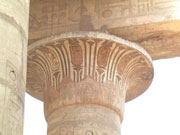TOUR NEWS -
ROMAN NORTH AFRICA (LIBYA AND TUNISIA) APRIL 2007
ROMAN NORTH AFRICA (LIBYA AND TUNISIA) APRIL 2007
The Roman North Africa tour in April 2007 went very well - we saw many fascinating sites and had a very enthusiastic and interested group. This included Bob and Kathy Parker, Harley Parker, Ann and Ian Brown, Jim and Lesley Hamilton, Wolfgang and Marisa Mitterhuemer, Mary-Ann and David Rose, Liz Anderson (a sucker for punishment as this was her second tour with B.C. Archaeology in the past year - well done Liz!!), Tony Howell, Alex Radford, Carmen Xuereb and Geraldine Read. The tour leader was Dr Michael Birrell.
The tour started in Cairo where we stayed overnight - we then headed north to Alexandria where we had a night in the comfortable Metropole Hotel, very close to the harbour. We explored some of the highlights of this historic city including Qaitbey Fort, site of the famous Lighthouse, and also saw the modern Library and its Museum. The following day we headed west along the Mediterranean coast and stopped at the WWII battle site of El Alamein. Here we saw the war museum and the nearby Commonwealth cemetery.
We stayed overnight in Mersa Matruh and then the following day made our way to the Libyan border. The crossing was an experience in Middle Eastern organisation, but eventually we got through! We made our way to the Tobruk war cemetery and stayed overnight near Tobruk harbour. The following day we went along the Libyan coast and stopped to see the picturesque ruins of Apollonia accompanied by local archaeologist Adb el Ghader. We then checked into our hotel in Bayda which would be our base for a few days while we explored the superb and tranquil site of Cyrene. This ancient Greek settlement, perched on the top of an escarpment, has panoramic views across to the sea. The most dramatic scenery is that from the sanctuary of Apollo. At the local restaurant, Tony Howell was given something of a make-over and ended up looking like Sheikh Omar el-Mohktar, the local Libyan resistance leader against Italian rule in the 1930s!!
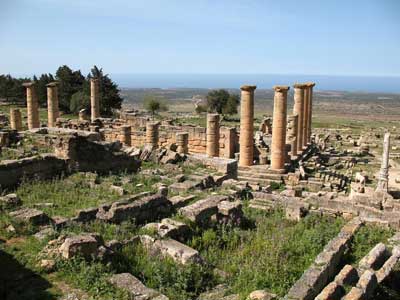 |
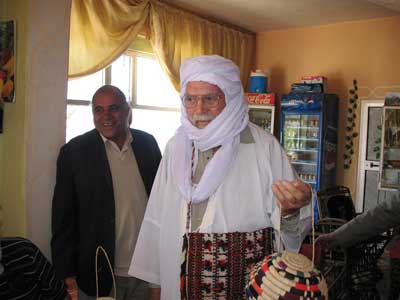 |
The sanctuary of Apollo at Cyrene |
Is that the Sheikh? No its Tony! |
The following morning we visited the superb remains of the temple of Zeus and also saw the site Museum with its outstanding collection of sculpture from Cyrene. We then headed west by bus to Benghazi, stopping en route to see the Hellenistic Greek and Roman ruins of the city of Ptolemais. Highlights included the well preserved theatre, houses with mosaics and the Roman cisterns. We also visited the local museum of antiquities and had a very pleasant picnic in the gardens. In the afternoon we flew to Tripoli and checked into our hotel - this was the comfortable Bab el-Bahr (the Gate of the Sea) Hotel, with panoramic views along the coast.
We next spent two days exploring the wonders of the massive Roman site of Leptis Magna. This is undoubtedly one of the most spectacular Roman ruins anywhere in the world. We had plenty of time to investigate the arch of Septimius Severus, the impressive theatre, the markets, the Old Forum, the Hadrianic baths, the Severan Forum and the Basilica. On the second day we explored the ancient harbour with its intact port and lighthouse, and saw the fantastic Roman amphitheatre nearby. We also visited the well laid out site museum with its beautiful collection of Roman sculpture. On the way back to Tripoli we stopped to see the ruins of the Villa Sileen, a remarkably well preserved private house with superb mosaics and frescoes.
Our day in Tripoli enabled us to see the Libyan national museum, home to a superb collection of Roman sculpture and mosaics. We had a pleasant lunch near the Red Fort, visited the arch of Marcus Aurelius, and had a walk in the Old City to do some shopping. The following day we headed west to see the Roman site of Sabratha. This ancient city is very well preserved, the highlight being the superb Roman theatre and the picturesque Forum near the sea shore. We also saw the Roman amphitheatre which retains a romantic tumble-down feel. The day ended with a visit to the Temple of Isis, perched romantically near the seashore, where we studied the literature of Apuleius and his evocative description of the festival of Isis.
 |
 |
The arch of Septimius Severus at Leptis Magna |
The theatre at Sabratha |
The next day we flew to Tunis where we checked into the centrally located Carlton Hotel and had a wander around the city. The following day we visited the Great Mosque in the Old City, saw the picturesque Tombs of the Beys, and also saw a beautiful old merchant's house. The rest of the day was one of rest and relaxation, with some members of the group taking the opportunity to buy carpets or explore the maze of shops in the Medina. Next on our itinerary was the magnificent Bardo Museum in Tunis, world-famous for its collection of Roman mosaics. These remarkable masterpieces, derived from a number of Tunisian sites, show many aspects of ancient life and religion. The collection is today housed in a beautiful Ottoman palace together with sculpture and art objects representative of Tunisian history.
The following morning we enjoyed a beautiful spring day exploring the ruins of the ancient Punic and Roman city of Carthage. We started at the Tophet cemetery, and then wandered around the Punic harbour where we saw the original slipways of the Punic fleet. We then went to the top of Bursa Hill where we saw the Museum and explored the ancient houses and the amphitheatre. In the afternoon we visited the picturesque suburb of Sidi Bou Said with its spectacular views of the Bay of Tunis. We had a coffee and smoked a water pipe in a local caf� as the sun went down over the Bay of Tunis.
We next had a day trip to the picturesque Cape Bon located to the east of Tunis. Here we saw the ruins of the ancient Punic settlement of Kerkouane. This is the best preserved Punic city in the world and is famous for its houses and temple. We also toured the local archaeological museum and had a pleasant seafood lunch with views overlooking the ocean.
The following day we travelled by bus through the green Medjerja River Valley. We had the entire afternoon to explore the spectacular ancient Roman site of Dougga which is located on a scenic hill overlooking the farmland. It was an evocative misty day as we explored the theatre, the Temple of Saturn, the impressive Capitol (Temple of Jupiter), the Roman bath complex and a number of houses with mosaic floors. In the late afternoon we had a short bus ride to El Kef where we checked into our hotel.
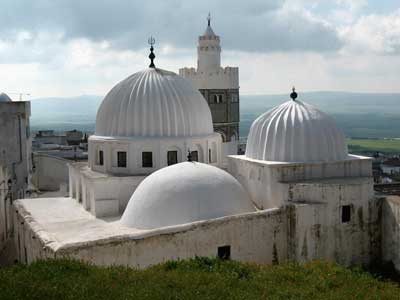 |
 |
Mosque in El kef |
The Temple of Minerva at Sufetula |
We spent the next morning in El Kef, a picturesque hill town with panoramic views of the local countryside. Here we visited the Sufi school with its collection of Berber artefacts and explored the Ottoman fortress. In the afternoon we travelled south to Sbeitla, location of the ancient Roman city of Sufetula. We subsequently explored this remarkable site, famed for its superb Temple of Mineva. Other highlights included the Arch of Diocletian, the Roman bridge and the house mosaics. The afternoon was free for a swim in the hotel pool.
The next day we headed east to the coastal city of Sousse stopping at the mediaeval city of Kairouan. Here we toured the impressive Grand Mosque which incorporates numerous columns from classical buildings. We also had a look at some carpets before taking a walk through the Kairouan medina. In the afternoon we headed to Sousse, a well preserved mediaeval city on the coast. There was free time the following day to explore the Grand Mosque and the fortified rabat (school) with its impressive watch tower, while some of the group visited the Late Ottoman house of a rich merchant family, or the beautiful Sousse Museum located within the fortified Kasbah.
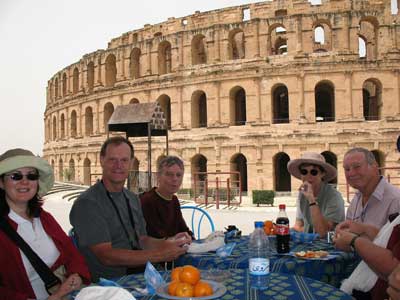 |
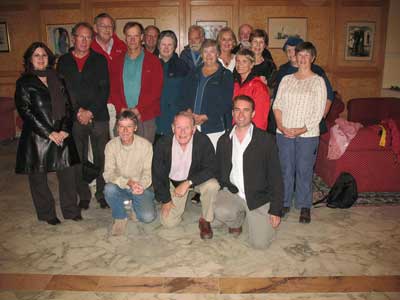 |
Lunch at El Jem near the amphitheatre |
The North Africa tour group |
The last day of the program was spent at El Jem, location of the ancient city of Thysdrus. In the morning we stopped to see how mosaics are made, and then saw the superb Museum of El Jem, housing remarkable Roman mosaics from the local area. Nearby was the 'House of Africa', a reconstructed Roman Villa. In the afternoon we saw the awe inspiring El Jem amphitheatre which still retains its underground cells for animals and gladiators. The restaurant outside must have one of the best views in the world! The following day we headed back to Tunis for our connecting flights. A very enjoyable tour!
Michael Birrell
